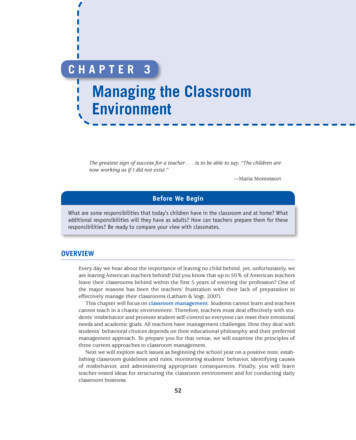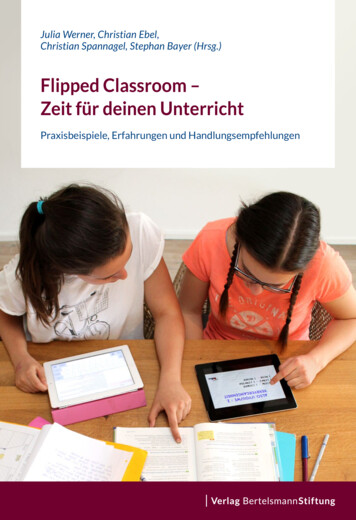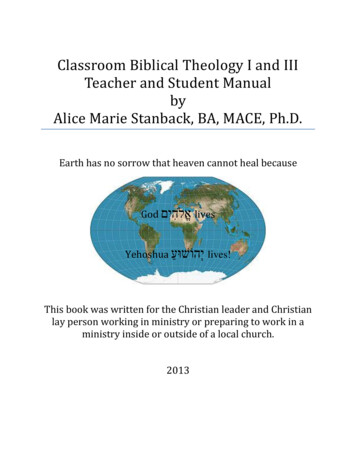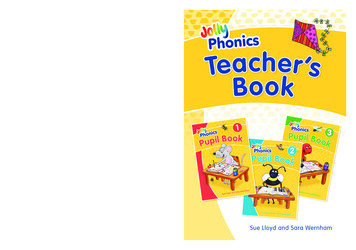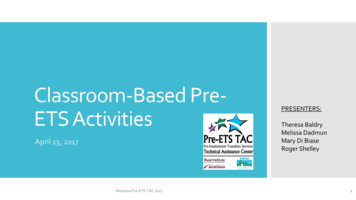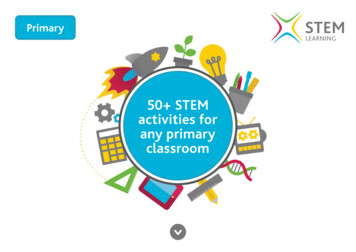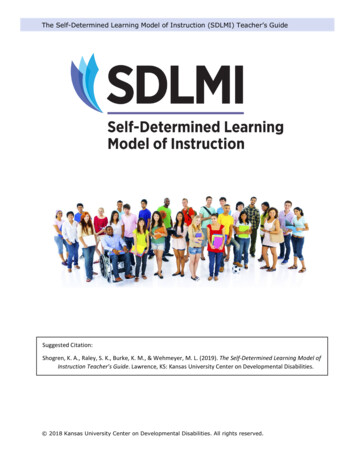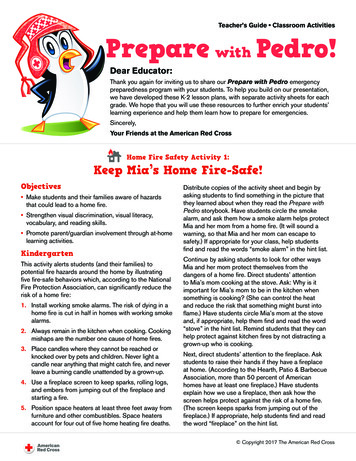
Transcription
Teacher’s Guide Classroom ActivitiesPrepare with Pedro!Dear Educator:Thank you again for inviting us to share our Prepare with Pedro emergencypreparedness program with your students. To help you build on our presentation,we have developed these K-2 lesson plans, with separate activity sheets for eachgrade. We hope that you will use these resources to further enrich your students’learning experience and help them learn how to prepare for emergencies.Sincerely,Your Friends at the American Red CrossHome Fire Safety Activity 1:Keep Mia’s Home Fire-Safe!Objectives Make students and their families aware of hazardsthat could lead to a home fire. Strengthen visual discrimination, visual literacy,vocabulary, and reading skills. Promote parent/guardian involvement through at-homelearning activities.KindergartenThis activity alerts students (and their families) topotential fire hazards around the home by illustratingfive fire-safe behaviors which, according to the NationalFire Protection Association, can significantly reduce therisk of a home fire:1. Install working smoke alarms. The risk of dying in ahome fire is cut in half in homes with working smokealarms.2. Always remain in the kitchen when cooking. Cookingmishaps are the number one cause of home fires.3. Place candles where they cannot be reached orknocked over by pets and children. Never light acandle near anything that might catch fire, and neverleave a burning candle unattended by a grown-up.4. Use a fireplace screen to keep sparks, rolling logs,and embers from jumping out of the fireplace andstarting a fire.5. Position space heaters at least three feet away fromfurniture and other combustibles. Space heatersaccount for four out of five home heating fire deaths.Distribute copies of the activity sheet and begin byasking students to find something in the picture thatthey learned about when they read the Prepare withPedro storybook. Have students circle the smokealarm, and ask them how a smoke alarm helps protectMia and her mom from a home fire. (It will sound awarning, so that Mia and her mom can escape tosafety.) If appropriate for your class, help studentsfind and read the words “smoke alarm” in the hint list.Continue by asking students to look for other waysMia and her mom protect themselves from thedangers of a home fire. Direct students’ attentionto Mia’s mom cooking at the stove. Ask: Why is itimportant for Mia’s mom to be in the kitchen whensomething is cooking? (She can control the heatand reduce the risk that something might burst intoflame.) Have students circle Mia’s mom at the stoveand, if appropriate, help them find and read the word“stove” in the hint list. Remind students that they canhelp protect against kitchen fires by not distracting agrown-up who is cooking.Next, direct students’ attention to the fireplace. Askstudents to raise their hands if they have a fireplaceat home. (According to the Hearth, Patio & BarbecueAssociation, more than 50 percent of Americanhomes have at least one fireplace.) Have studentsexplain how we use a fireplace, then ask how thescreen helps protect against the risk of a home fire.(The screen keeps sparks from jumping out of thefireplace.) If appropriate, help students find and readthe word “fireplace” on the hint list. Copyright 2017 The American Red Cross
Direct students’ attention to the candle on themantelpiece. Have students talk about where and howtheir family uses candles. Point out that Mia’s mom hasplaced the candle out of reach of children and pets, andfar away from anything that might catch fire, and shecan see the candle from the kitchen. Ask: What shouldMia’s mom do if she has to leave the kitchen? (Turn offthe stove and extinguish the candle.) If appropriate, helpstudents find and read the word “candle” on the hint list.Finally, direct students’ attention to the space heater.Ask students to raise their hands if their family uses aspace heater. Talk about how a space heater works andwhy Mia and her mom keep their space heater at leastthree feet away from anything that could catch on fire.If appropriate, help students find and read the word“heater” on the hint list.Ask students if they can think of any other ways tokeep a home fire-safe. Prompt them to recognize thisimportant fire safety rule:Never play with matches or lighters. Remindgrown-ups to keep matches and lighters storedaway where children cannot see or reach them.Read the directions at the end of the activity, which tellstudents to work with a grown-up to find ways to helpmake their home fire-safe. Students are asked to listtwo things they did to make their home fire-safe, and todraw a picture that shows one of the ways they madetheir home fire-safe. Schedule time the next day forstudents to share their lists and pictures.Grade 1This activity alerts students (and their families) topotential fire hazards around the home by illustratingfive fire-safe behaviors which, according to the NationalFire Protection Association, can significantly reduce therisk of a home fire:1. Install working smoke alarms. The risk of dying in ahome fire is cut in half in homes with working smokealarms.2. Always remain in the kitchen when cooking. Cookingmishaps are the number one cause of home fires.3. Place candles where they cannot be reached orknocked over by pets and children. Never light acandle near anything that might catch fire, and neverleave a burning candle unattended by a grown-up.4. Use a fireplace screen to keep sparks, rolling logs,and embers from jumping out of the fireplace andstarting a fire.5. Position space heaters at least three feet away fromfurniture and other combustibles. Space heatersaccount for four out of five home heating fire deaths.Complete this activity as a class. Distribute copies ofthe activity sheet and begin by asking students to findsomething in the picture that they learned about whenthey read the Prepare with Pedro storybook. Oncethey identify the smoke alarm, ask how a workingsmoke alarm helps protect Mia and her mom from ahome fire. (It will sound a warning, so that Mia andher mom can escape to safety.) Have students drawa circle around the smoke alarm and a line from thesmoke alarm to its name.Follow a similar procedure as you guide studentsthrough the remaining fire-safe behaviors in the picture,or you can turn the activity into an I Spy game by givingclues for each fire-safe behavior until the students findit. Prompt them to explain how each behavior helpsprotect Mia and her mom from the risk of a home fire.For example: Why is it important for Mia’s mom to be in the kitchenwhen something is cooking? (She can control theheat and reduce the risk that something might burstinto flame.) How does the fireplace screen help protect againstthe risk of a home fire? (The screen keeps sparksfrom jumping out of the fireplace.) Why is the mantelpiece a fire-safe place for thecandle? (It is out of reach of children and pets, andfar away from anything that might catch on fire.)Why is it important that Mia’s mom is able to see thecandle from the kitchen? (There should always be agrown-up watching when a candle is burning.) How does the position of the space heater helpprotect against home fire? (It is at least three feetaway from anything that could catch on fire.)As they find each fire-safe behavior, have studentscircle it and draw a line to its name. Copyright 2017 The American Red Cross
Ask students if they can think of any other ways tokeep a home fire safe. Prompt them to recognize thisimportant fire safety rule:Never play with matches or lighters. Remindgrown-ups to keep matches and lighters storedaway where children cannot see or reach them.Conclude by having students read the directions atthe end of the activity, which tell them to work witha grown-up to find ways to help make their homefire-safe. Students are asked to list two things theydid to make their home fire-safe, and to draw apicture that shows one of the ways they madetheir home fire-safe. Schedule time the next dayfor students to share their lists and pictures.Grade 2This activity alerts students (and their families) topotential fire hazards around the home by illustratingfive fire-safe behaviors which, according to the NationalFire Protection Association, can significantly reduce therisk of a home fire:1. Install working smoke alarms. The risk of dying ina home fire is cut in half in homes with workingsmoke alarms.2. Always remain in the kitchen when cooking.Cooking mishaps are the number one cause ofhome fires.3. Place candles where they cannot be reached orknocked over by pets and children. Never light acandle near anything that might catch fire, and neverleave a burning candle unattended by a grown-up.4. Use a fireplace screen to keep sparks, rolling logs,and embers from jumping out of the fireplace andstarting a fire.5. Position space heaters at least three feet awayfrom furniture and other combustibles. Spaceheaters are responsible for four out of five homeheating fire deaths.Distribute copies of the activity sheet, read thedirections together, and have students complete theactivity individually, then review their answers in aclass discussion. Prompt students to explain how eachbehavior helps protect Mia and her mom from the risk ofa home fire. For example: Why is it important for Mia’s mom to be in the kitchenwhen something is cooking? (She can control theheat and reduce the risk that something might burstinto flame.) How does the fireplace screen help protect againstthe risk of a home fire? (The screen keeps sparksfrom jumping out of the fireplace.) Why is the mantelpiece a fire-safe place for thecandle? (It is out of reach of children and pets, and faraway from anything that might catch on fire.) Why isit important that Mia’s mom is able to see the candlefrom the kitchen? (There should always be a grown-upwatching when a candle is burning.) How does the position of the space heater helpprotect against home fire? (It is at least three feetaway from anything that could catch on fire.)Ask students if they can think of any other ways tokeep a home fire safe. Prompt them to recognize thisimportant fire safety rule:Never play with matches or lighters. Remindgrown-ups to keep matches and lighters storedaway where children cannot see or reach them.Conclude by having students read the directions atthe end of the activity, which tell them to work with agrown-up to find ways to help make their home firesafe. Students are asked to list two things they did tomake their home fire-safe, and to draw a picture thatshows one of the ways they made their home fire-safe.Schedule time the next day for students to share theirlists and pictures.Answers: 1-smoke alarm; 2-candle; 3-stove; 4-heater;5-fireplace. Copyright 2017 The American Red Cross
Home Fire Safety Activity 2:ObjectivesMake an Escape Plan! Teach students and their families the importance ofidentifying two escape paths from every room in theirhome so that they will have an alternate escape pathif their primary escape path is blocked by flames. Reinforce the need to identify a family meeting placeoutside the home where all family members gatherafter they have escaped a home fire so that everyoneknows who is safe. Encourage parents/guardians to create a home fireescape plan and conduct family fire drills at leasttwice a year with the goal that all family members canget outside in less than two minutes. Strengthen visual discrimination and visual literacy skills,fine motor skills, and vocabulary and reading skills. Promote parent/guardian involvement through at-homelearning activities.Kindergarten1ST ESCAPE PATH2ND ESCAPE PATHThis activity introduces students to the importance ofidentifying two escape paths from every room in theirhome so that they will have an alternate escape path iftheir primary escape path is blocked by flames.Distribute copies of the activity sheet and read thedirections aloud. Ask: Why do you think we need tofind two ways to get outside from every room at home?Guide students toward an understanding that our usualpathways to the outside might be blocked by flamesduring a home fire. That’s why we need to plan aheadand find a second way to get outside from every room.Work as a class to identify the two ways out of eachroom illustrated on the activity sheet. Have students writea “1” on the doorway in each illustration, and a “2” on thewindow. Emphasize that it is important to escape from ahome fire and not try to hide from the danger in a closet.Read the directions for the take-home part of thisactivity and review the illustration of a home fire escapeplan. Have students go room by room through theillustration tracing the two escape paths for each room.Distribute copies of the take-home worksheet and tellstudents that they will be working with a grown-up todraw a map that shows two escape paths for everyroom in their home. As they work on their map, studentsand their families should: Make sure that it is easy to open windows and doorsalong all escape paths, and move any furniture orother items that may block the way.1ST ESCAPE PATH Make sure that any windowNDsecurity bars have a2 ESCAPE PATHquick-release mechanism thatis easy to open in anemergency. Consider purchasing escape ladders for second storywindows (relatively inexpensive at local hardwarestores).Call attention to Mia’s family meeting place in theillustration. Ask: Why is a family meeting place important?Explain that a home fire is confusing, and different familymembers might use different escape paths. You need afamily meeting place where everyone goes once they getoutside so that you know everyone is safe. A good familymeeting place is: At a specific, fixed location. At a safe distance from the home. In the front, so you can meet the firefighters when theyarrive and tell them that everyone in the family is safe.Remind students that for a family meeting place towork, everyone needs to know where it is and staythere — Get Out and Stay Out! Copyright 2017 The American Red Cross
Ask students to describe places where their familiescould meet up in case of a home fire. Remind studentsthat they are to choose a family meeting place with agrown-up at home and bring a drawing or photo of theirmeeting place to class. Schedule time the next day forstudents to share their pictures. Make sure that it is easy to open windows and doorsalong all escape paths, and move any furniture orother items that may block the way.Grade 1 Consider purchasing escape ladders for second storywindows (relatively inexpensive at local hardwarestores).This activity introduces students to the importance ofcreating a home fire escape plan that identifies twoescape paths from every room in their home so thatthey will have an alternate escape path if their primaryescape path is blocked by flames.Distribute copies of the activity sheet and read thedirections aloud. Ask: Why do you think we need tofind two ways to get outside from every room at home?Guide students toward an understanding that our usualpathways to the outside might be blocked by flamesduring a home fire. That’s why we need to plan aheadand find a second way to get outside from every room.Emphasize that it is important to escape from a homefire and not try to hide from the danger in a closet.Have students work individually to draw two pathsoutside from each room in the diagram, or you canwalk them through the activity by calling on students todescribe the different escape paths from each room.Read the directions for the take-home part of thisactivity. Distribute copies of the take-home worksheetand tell students that they will be working with agrown-up to draw a map that shows two escape pathsfor every room in their home. As they work on their map,students and their families should: Make sure that any window security bars have aquick-release mechanism that is easy to open in anemergency.Call attention to Mia’s family meeting place in theillustration. Ask: Why is a family meeting placeimportant? Explain that a home fire is confusing, anddifferent family members might use different escapepaths. You need a family meeting place where everyonegoes once they get outside so that you know everyoneis safe. A good family meeting place is: At a specific, fixed location. At a safe distance from the home. In the front, so you can meet the firefighters when theyarrive and tell them that everyone in the family is safe.Remind students that for a family meeting place towork, everyone needs to know where it is and staythere — Get Out and Stay Out!Ask students to describe places where their familiescould meet up in case of a home fire. Remind themto mark their family meeting place on the escape planmap they make with a grown-up at home. Scheduletime the next day for students to share their escapeplan maps in class. Copyright 2017 The American Red Cross
Grade 2This activity introduces students to the importance ofcreating a home fire escape plan that identifies twoescape paths from every room in their home so thatthey will have an alternate escape path if their primaryescape path is blocked by flames.Distribute copies of the activity sheet and read thedirections aloud. Ask: Why do you think we need tofind two ways to get outside from every room at home?Guide students toward an understanding that our usualpathways to the outside might be blocked by flamesduring a home fire. That’s why we need to plan aheadand find a second way to get outside from every room.Emphasize that it is important to escape from a homefire and not try to hide from the danger in a closet.Have students work individually to draw two pathsoutside from each room in the diagram, or you canwalk them through the activity by calling on students todescribe the different escape paths from each room.Read the directions for the take-home part of thisactivity. Distribute copies of the take-home worksheetand tell students that they will be working with agrown-up to draw a map that shows two escape pathsfor every room in their home. As they work on their map,students and their families should: Make sure that it is easy to open windows and doorsalong all escape paths, and move any furniture orother items that may block the way. Make sure that any window security bars have aquick-release mechanism that is easy to open in anemergency. Consider purchasing escape ladders for secondstory windows (relatively inexpensive at localhardware stores).Call attention to Mia’s family meeting place in theillustration. Ask: Why is a family meeting placeimportant? Explain that a home fire is confusing, anddifferent family members might use different escapepaths. You need a family meeting place where everyonegoes once they get outside so that you know everyoneis safe. A good family meeting place is: At a specific, fixed location. At a safe distance from the home. In the front, so you can meet the firefighters when theyarrive and tell them that everyone in the family is safe.Remind students that for a family meeting place towork, everyone needs to know where it is and staythere — Get Out and Stay Out!Ask students to describe places where their familiescould meet up in case of a home fire. Remind them tomark their family meeting place on the escape plan mapthey make with a grown-up at home. Schedule time thenext day for students to share their escape plan maps inclass.Conclude by having students complete the Home FireEscape Rules section of the activity on their own, andreview their answers in a class discussion. Remindstudents to share these rules with their family.Answers:1. Never take anything with you when you areescaping a home fire.2. Get low and go when you have to escape throughsmoke.3. After you get to your meeting place, remind a grownup to call 9-1-1.4. Stay outside! You should never go back into aburning building. Copyright 2017 The American Red Cross
Always remain in the kitchen when cooking. Cooking mishaps are the number one cause of home fires. 3. Place candles where they cannot be reached or knocked over by pets and children. Never light a candle near anything that might catch fire, and never leave a burning candle unattended by
